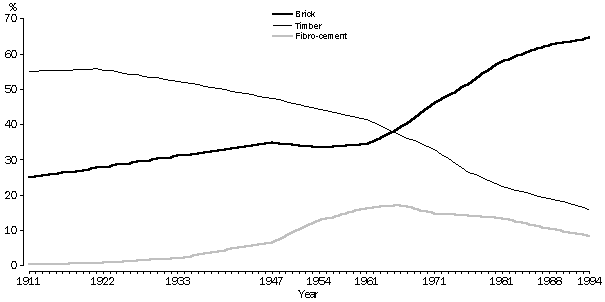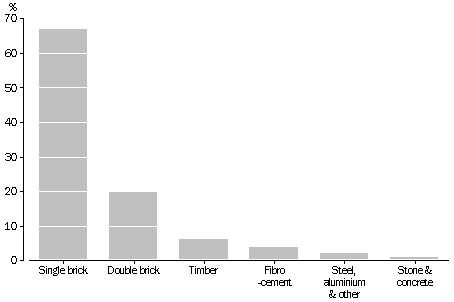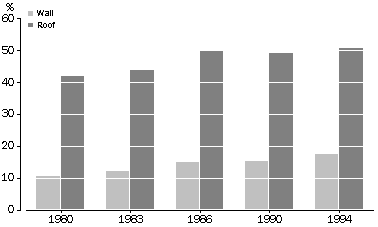Housing Stock: Trends in housing
Most Australian homes have brick walls and at least three bedrooms and are heated by electricity or mains gas.
Housing construction and design methods have changed over time in response to changing housing needs. These changing needs result from factors such as changes in the age structure of the population, household composition, family size, labour force participation and lifestyle (see Australian Social Trends 1994, Changes in living arrangements).
The link between housing and lifestyle is of increasing importance. The growing need to tailor housing to people's lifestyles is changing housing design and construction. The home is often now the site for activities such as home-based employment and home leisure (see Home workers and Leisure at home) as well as family living. Increasingly, people require housing designed with purpose-built space for such activities.
Environmental concerns have also influenced housing design and construction. It is recognised that poorly designed and constructed dwellings can contribute to environmental problems through inefficient energy use. However, energy can be used more efficiently in homes by an appropriate use of solar energy and natural climatic influences. Data for monitoring such issues are currently limited to those available on the use of alternative housing materials, fuels and insulation.
Dwelling numbers and size
A dwelling is defined by the ABS as a self-contained suite of rooms for a household that is intended for long-term residential use and has facilities for cooking and bathing. Between 1961 and 1994 the number of occupied dwellings in Australia more than doubled, from 2.8 million to 6.7 million. In 1961, 88% of occupied dwellings were separate houses. By 1994 this had decreased to 79%. The increase in the number of dwellings outstripped the increase in the population over this period, and therefore the average number of occupants per dwelling decreased, from 3.6 to 2.7.
Despite housing fewer people on average, dwellings are getting bigger. The number of separate houses with four or more bedrooms increased from 15% in 1971 to 23% in 1994. Between 1984 and 1994, the average size of newly constructed private dwellings increased by 15% to 192 square metres (see Housing - National summary tables).
Housing materials
Between 1911 and 1994 over three-quarters of all private occupied dwellings had outer walls of made brick or timber, traditional materials used for the outer walls of Australian buildings.
However, there has been a long-term shift away from timber towards brick as the most popular material for outer walls. In 1911, 55% of dwellings had outer walls made of timber and 25% had outer walls made of brick. In 1966 for the first time there was a greater proportion of dwellings with brick outer walls than timber. In 1981, 58% of dwellings had outer walls made of brick and 22% had outer walls made of timber. By 1994, 65% of dwellings had outer walls made of brick and 16% had outer walls made of timber.
The proportion of dwellings with outer walls made of fibro-cement increased between 1933 and 1961 to 16% of all dwellings and then decreased to 13% by 1981. By 1994, 8% of dwellings had outer walls made of fibro-cement.
Recent data on the material used for the outer walls of new dwellings show the continuing preference for brick. In 1993-94, 87% of new dwellings had outer walls of brick; 67% were single brick and 20% were double brick. Only 6% of new dwellings had timber outer walls.
There were significant differences in the materials used for outer walls between states and territories. In 1993-94, 87% of new dwellings in Western Australia and 66% in the Northern Territory had outer walls of double brick. In the other states and territories the proportion with double brick ranged from 13% (New South Wales) to 1% (Victoria and the Australian Capital Territory). Single brick new dwellings were most common in the Australian Capital Territory (97%), South Australia (88%) and Victoria (86%). Tasmania had the highest proportion (14%) of new dwellings built with timber walls.
MATERIALS OF OUTER WALLS OF OCCUPIED PRIVATE DWELLINGS

Source: Census of Population and Housing (1911-1981); Australian Housing Survey (1988 and 1994).
MATERIALS USED FOR OUTER WALLS OF NEW DWELLINGS, 1993-94

Source: Building Approvals
Cost of materials
Between 1987 and 1994 the cost of materials used in house building increased by 44% (see Housing - National summary tables). One factor in this increase may have been the cost of using materials to build more environmentally friendly dwellings. While energy conservation measures, such as solar energy and insulating walls and ceilings, may add to the initial cost of construction, the longer term financial savings, as well as savings to natural resources, are considered important by many home buyers1.
Rooms and amenities
The number and types of rooms and amenities in a dwelling can be used as a broad indicator of its size and characteristics. In 1994, 70% of dwellings had three or more bedrooms. 83% of separate houses had three or more bedrooms, compared to 37% of semi-detached houses and 10% of flats/units. 23% of dwellings had two or more bathrooms or ensuites. 74% of dwellings had separate toilets (rooms). Separate houses were more likely to have these facilities than other types of dwellings.
Dual flush toilets and reduced flow shower heads are seen as environmentally friendly because they use less water. In 1990, 25% of dwellings had dual flush toilets. By 1994, 39% of households had dual flush toilets and 22% of households had reduced flow shower heads.
PROPORTION OF DWELLING TYPES WITH SELECTED ROOMS/AMENITIES, 1994
|
 | Separate house | Semi-detached(a) | Flat/unit | Other(b) | All dwellings |
| Rooms/amenities | % | % | % | % | % |
|
| 3 or more bedrooms | 83.4 | 37.0 | 10.2 | 0.0 | 70.4 |
| 2 or more bathrooms or ensuites | 27.7 | 9.5 | 5.1 | 0.0 | 23.3 |
| Separate toilets (rooms) | 81.4 | 64.4 | 37.4 | 27.4 | 74.4 |
| Laundries | 95.9 | 81.5 | 49.8 | 20.8 | 88.8 |
| Studies/sunrooms | 27.7 | 6.4 | 5.1 | 0.0 | 23.2 |
| Dual flush toilets | 40.6 | 45.0 | 25.1 | 20.9 | 39.0 |
| Reduced flow shower heads | 24.1 | 15.1 | 10.1 | 15.5 | 21.8 |
 |
 | '000 | '000 | '000 | '000 | '000 |
| Total | 5,300.7 | 527.9 | 832.5 | 16.8 | 6,677.9 |
|
(a) Includes row/terrace houses and townhouses.
(b) Includes caravans not in caravan parks, houseboats, improvised homes and houses and flats attached to shops. These dwellings will often not be self contained.
Source: Australian Housing Survey; Environmental Issues Survey
Heating and insulation
The source of energy used for household lighting, water heating and room heating has been a focus of environmental concern in recent years. In 1994, 37% of households used electricity for room heating and 29% used mains gas. 17% of households used wood or coal for room heating. The most commonly used fuels for heating water were electricity (61%) and mains gas (31%).
Due to climatic variations across Australia, there are marked differences between the states and territories in the use of household heating. While over 99% of households in Tasmania, Victoria and the Australian Capital Territory used energy for room heating, only 18% of households in the Northern Territory and 45% of households in Queensland did so.
Overall, the proportion of dwellings with insulation increased slightly between 1980 and 1994. In 1980, 11% of dwellings were reported as having wall insulation and 42% with roof insulation. In 1990 the proportions had increased to 15% and 49% respectively with 13% of dwellings reported as having both wall and roof insulation. By 1994, 18% of dwellings were reported as having wall insulation and 51% as having roof insulation. 15% of households were reported as having both wall and roof insulation.
In 1994 the main reasons why households installed insulation were because it was thought to be warmer in winter and cooler in summer and it would save on energy bills. The main reasons why households without insulation had not installed it were the cost, being uninterested in it or not having thought about it, or thinking that it was unnecessary because of the climate.
PROPORTION OF HOUSEHOLDS USING SELECTED ENERGY SOURCES, 1994
|
 | Room heating | Hot water |
| Fuel | % | % |
|
| Electricity | 36.8 | 60.6 |
| Mains gas | 28.7 | 30.8 |
| Wood/coal | 16.8 | (a) |
| Solar | (a) | 4.6 |
| Bottled gas | 3.2 | (a) |
| Oil | 2.8 | (a) |
| Other | 1.6 | 4.0 |
| None | 10.1 | (a) |
 |
| All households | 100.0 | 100.0 |
|
(a) Included in other.
Source: Australian Housing Survey
PROPORTION OF DWELLINGS WITH INSULATION

Sources: National Energy Surveys; Survey of Income & Housing Costs and Amenities (1990); Australian Housing Survey (1994)
Endnotes
1 National Housing Strategy (1992) Housing choice: reducing the barriers Issues paper no. 6.
2 Housing Characteristics and Decisions: A Comparative study of Sydney, Melbourne, Adelaide and Canberra (8710.0).
 Print Page
Print Page
 Print All
Print All